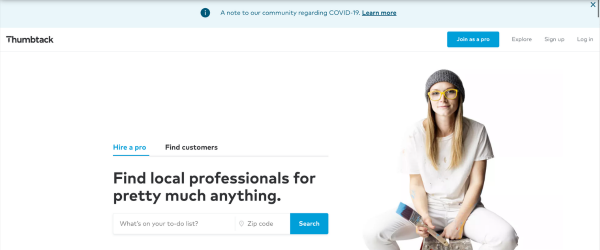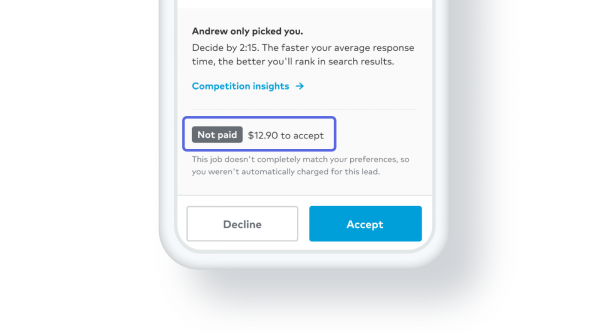How did Thumbtack build a billion-dollar marketplace? Here’s what you need to know about Thumbtack’s business model and how it works.
Build your online marketplace today!
Benefit from a 7-day free trial, with no obligation or payment card
Want to know how Thumbtack succeeded in creating a successful, billion-dollar marketplace startup?
Today, you’ll learn all about Thumbtack’s business model, growth strategies and more and how to use this to grow your own marketplace business.
Want to learn more? Read on!

Source: Pexel
What does Thumbtack’s business model look like?
The way Thumbtack works is that service providers offer their services on the platform (the list of services is long and they include services like cleaning and house repairs). Customers post jobs, choose from bids by service providers and contract the business that is the most suitable for their needs.

Today, Thumbtack’s valuation is $1.7 billion. (However, Thumbtack has seen its revenues drop due to the COVID-19 crisis. It’s too early to say how this will affect the company in the long-term.)
And why is it valued so high? Thumbtack’s revenues have grown 125% year-over-year. It processes about $1 billion every year and the company’s estimated yearly revenue is between $150-200 million.
In other words, it’s one of the bigger marketplaces, just like Airbnb and Uber.
Of course, this was not always the case.
The company, founded in 2009, was launched as a marketplace for services. Thumbtack’s value proposition has been the same since day one: To provide all types of services all over the US. Initially, it didn’t attract many investors and it had to pivot several times to create a revenue model that worked.
And what does this revenue model look like? Here’s what you need to know.
How Thumbtack makes money
Today, Thumbtack makes money by selling leads to service providers. So, when someone opts to work with a service provider on the platform, Thumbtack will charge a fee from the service provider.
The cost per lead depends on the project size, market, and how many other available vendors there are.

You can read more about Thumbtack’s pricing model here.
Thumbtack vs TaskRabbit
When Thumbtack was founded, there weren’t that many similar marketplaces around. However, one of its main competitors, TaskRabbit, had already opened its doors in 2008. Today, TaskRabbit has been acquired by IKEA, while Thumbtack is still an independent business.
The main difference between TaskRabbit’s and Thumbtack’s business models is that Thumbtack works with professional service providers, whereas TaskRabbit’s service providers can be people who earn a side income from their services.
TaskRabbit is also present in fewer states and Thumbtack offers bidding for projects, which TaskRabbit doesn’t.
Now you know what Thumbtack’s business model looks like. But how did initially start growing -- and how did it grow so fast it got a billion-dollar valuation? That's what we’ll look at next.
How did Thumbtack grow its business?
When Thumbtack was founded, it got started in an economy that was in a recession. That made it so much harder to find funding (as is usual for similar, San Francisco-based companies), which forced the company to quickly come up with a profitable business model.
Different pricing models and markets
First, it tried a commission model where the vendors pay a percentage of their earnings to the platform. As this didn’t work out, the company went for a subscription model where vendors pay a certain amount for leads that they generate off of Thumbtack. This revenue model proved to be much more successful.
The other factor that helped the business get traction fast was that it focused on different “pockets” of the market that were lucrative (such as events). This meant that it could grow with scale in several different areas all at once.
Different ways to scale
Thumbtack used a few different ways to grow and scale its business early on.
For example, it created a tool that allowed providers to post a good-looking listing to Craigslist. That way, it was able to scrape Craigslist users to start using its own services.
Also, one of the ways Thumbtack retained its users was to upsell them to different services (for example, a user who had used a carpet cleaning service might try a moving service).
So, now you know what it took for Thumbtack to grow. Can you do the same? Let’s have a look.
Can you copy Thumbtack’s growth strategies?
The question you might be asking yourself right now is:
“Can I use these strategies to grow my own business?”
Every startup story has lessons to learn from. And so does Thumbtack -- you can certainly get inspired by its growth strategies.
But:
Growing your business just like Thumbtack probably isn’t the best idea.
The company was founded in 2009 and marketplace businesses were not a huge deal back then. There were few competitors doing the exact same thing as Thumbtack.
In other words, Thumbtack had completely different challenges to solve when it started then you probably have now.
Here’s how to grow YOUR marketplace in the conditions that are prevalent today.
Find a niche!
First, Thumbtack didn’t really have a niche when it launched. It offered all types of services to everyone.
We always recommend you to choose a niche (here and here).
The reason is simple. With a niche, you stand out. The people you target understand why they should use your platform instead of another platform.
For example, if your platform connects pet sitters with pet owners, it will be much easier to get users to sign up than if your marketplace offers all kinds of services to everyone.
To get inspired, take a look at our customers Clik Trip, a curated photography marketplace connecting customers to recommended local photographers and high-quality photo experiences around the world, and Ellect, a marketplace that connects microenterprises with corporate and government procurement buyers.
Market your marketplace scalably
Thumbtack got early traction by scraping Craigslist. While that might have worked in 2009, it was already then against Craigslist’s terms and conditions. And today, it would be hard to pull off something similar.
Instead, use proven strategies to grow your marketplace. Yes, finding strategies that help you scale while being easy to execute is never easy. But to get started, you can engage with people in social media groups (Facebook, Reddit, and other online forums) and use this to grow a loyal audience. And once you have your first users, the list of things you can do to grow your marketplace is long:
- Tap into word-of-mouth marketing.
- Use paid advertising.
- Use SEO and blogging.
- Grow your business organically on social media.
- Grow your business with the help of influencers.
Read our full marketing guide here.
Use a commission pricing model
Depending a bit on the type of marketplace you start, the most profitable pricing model is probably going to be a commission pricing model. Thumbtack, on the other hand, opted for a lead-based pricing model because commissions didn’t work for it.
If you’re unsure, try a few pricing models and see which one gets you the most users and profits. Read more about pricing here.
Get started faster
You have one clear advantage over Thumbtack:
Many of the tools that make it extremely easy to start a marketplace didn’t exist in 2009.
Today it’s easier than ever to create, market, and grow your marketplace.
Take Kreezalid, our own business.
We offer a no-code marketplace website SaaS that lets you set up your own marketplace website with a few clicks.
By tapping into these types of tools, you can start your own marketplace right away.
Want to learn more?
There you have it. Now you know what Thumbtack’s business model looks like. You also know how the company grew… And if you should use its growth strategies. The short answer: Probably not, even if there are always things to learn from every growth story.
Are you looking to build your marketplace business?
Then, try Kreezalid for 14 days for free. (No credit card required.)

